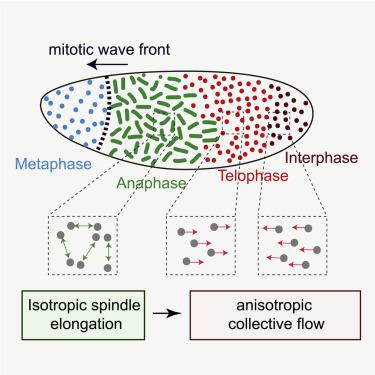Current Biology ( IF 8.1 ) Pub Date : 2020-05-28 , DOI: 10.1016/j.cub.2020.04.078 Zhiyi Lv 1 , Jan Rosenbaum 2 , Stephan Mohr 3 , Xiaozhu Zhang 4 , Deqing Kong 5 , Helen Preiß 6 , Sebastian Kruss 6 , Karen Alim 7 , Timo Aspelmeier 2 , Jörg Großhans 5

|
Many aspects in tissue morphogenesis are attributed to a collective behavior of the participating cells. Yet, the mechanism for emergence of dynamic tissue behavior is not well understood. Here, we report that the “yo-yo”-like nuclear movement in the Drosophila syncytial embryo displays emergent features indicative of collective behavior. Following mitosis, the array of nuclei moves away from the wave front by several nuclear diameters only to return to its starting position about 5 min later. Based on experimental manipulations and numerical simulations, we find that the ensemble of elongating and isotropically oriented spindles, rather than individual spindles, is the main driving force for anisotropic nuclear movement. ELMO-dependent F-actin restricts the time for the forward movement and ELMO- and dia-dependent F-actin is essential for the return movement. Our study provides insights into how the interactions among the cytoskeleton as individual elements lead to collective movement of the nuclear array on a macroscopic scale.
中文翻译:

在伪同步有丝分裂周期中由细胞骨架重塑驱动的细胞核出现溜溜球运动。
组织形态发生的许多方面都归因于参与细胞的集体行为。然而,动态组织行为出现的机制尚不清楚。在这里,我们报告了果蝇合胞体胚胎中类似“溜溜球”的核运动显示出指示集体行为的紧急特征。有丝分裂后,细胞核阵列以几个核直径远离波前,仅在大约 5 分钟后返回其起始位置。基于实验操作和数值模拟,我们发现伸长和各向同性定向的纺锤体的集合,而不是单个纺锤体,是各向异性核运动的主要驱动力。埃尔莫-依赖的 F-肌动蛋白限制了向前运动的时间,而ELMO - 和dia依赖的 F-肌动蛋白对于返回运动至关重要。我们的研究提供了关于细胞骨架作为单个元素之间的相互作用如何导致核阵列在宏观尺度上的集体运动的见解。









































 京公网安备 11010802027423号
京公网安备 11010802027423号